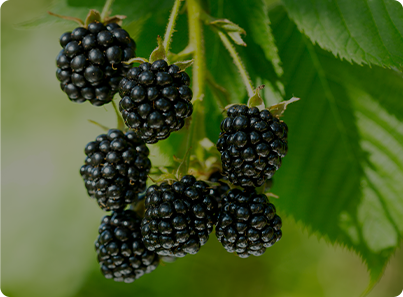Blackberries are one of the simplest fruits to grow. If properly managed and irrigated, good-quality plantings produce crops for at least 15 years. Blackberry fruit offers a variety of unique flavors ranging from sweet to sour. They are used in their fresh, frozen, or tinned form. These traits make blackberries a popular home garden crop.
Blackberries are native to the United States, which is one of the reasons for their resilience. Zones 5 to 9 are suitable for these berries. The bushes produce delicious fruit for around three or four weeks during the summer. The Rosaceae family is home to a wide variety of delicious plants, including blackberries, raspberry bushes, roses, and apple trees.
Blackberries, which are closely related to raspberries, are classified as brambles because they typically possess thorns, a thick and tangled growth, and either stand erect or sprawl. Blackberries, unlike raspberries, preserve their cores when harvested.
Blackberries are a type of perennial plant that produces fruit on canes that live for only two years. Every year, they produce new green stems known as primocanes. Ouachita is a thornless, upright blackberry with a medium size. It ripens in the second week of June and requires 400 to 500 hours of chilling time. Orange rust, double flower, and anthracnose resistance are all present in the firm berries, which allow for longer preservation than most blackberries.
Ouachita Blackberry Size
The Ouachita Thornless Blackberry is a broad, tasty blackberry with no thorns. The canes of the thornless Ouachita Blackberry are exceptionally upright and erect. It has a delicious flavor and is extremely prolific. The Ouachita Blackberry has a very high capacity for fruit storage and handling. The fruiting season of these blackberries is the mid-season.
Blackberries do best in full sun and require between 5.5 and 7.0 pH soil that is loamy and well-drained. These plants grow properly in the presence of direct sunlight. Their usual size and spread vary greatly, but if more than one blackberries are planted, then the space between them is three to five feet apart.
Ouachita Blackberry Care
To keep blackberries healthy and strong, they only need a little trimming. Each spring, prune each plant’s center primocanes to 3-4 feet. Because of this, the plant is encouraged to direct its energy into the growth of laterals. However, it is also required to clip these back to approximately 12 inches in length. As the plant enters dormancy and temperatures drop in late autumn, it is time to prune once more.
Blackberries are susceptible to various kinds of pests. To protect the blackberries from various illnesses and pests, it is important to avoid watering them from above, use healthy stock, and clean gardening tools before planting the berries.
Ouachita Blackberry Zone and Taste
Blackberries are very juicy and have both sweet and sour taste. Blackberries are self-fertile, so there is no need to grow another kind close for cross-pollination.
The hardiness zones are a guide that is used to identify plant varieties that are likely to thrive in particular environment. Each zone represents the lowest winter temperatures in a certain location. Before purchase, it is important to make sure that the hardiness zone is compatible with this variety’s zone compatibility range.USDA Hardiness Zones for this variety of blackberry are 5–9. There are prickles of several types, however, this variety is thornless. The thorny types are easier to maintain, although many individuals prefer these thornless kinds because they are simpler to harvest.
Ouachita Blackberry Growing Instructions
While blackberries may grow in practically any soil, the best conditions are high-organic-matter loam soils with a pH ranging between 5.5 snd 6.5. Blackberries require regular irrigation to ensure the best possible production and fruit quality. It is critical to include an irrigation system in place, or at the very least to plant near a water supply.
Blackberry bushes with no thorns are usually developed from seedlings. They are grown from seeds, but it takes a lot longer. Although certain types may tolerate moderate shade, choose a sunny location to plant the blackberries.
Plants are spaced between three and seven feet apart because blackberry stems reach lengths of several feet. If they’re bare-root, make a hole shallow enough for the plant’s roots and gently spread them out before planting. Loosened earth is mostly used to fill the hole.



